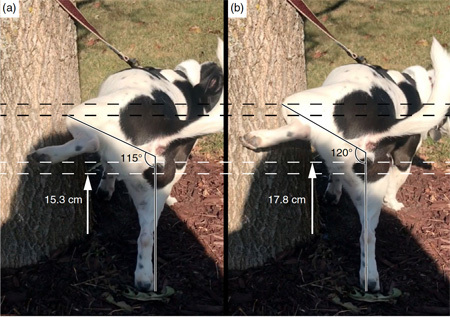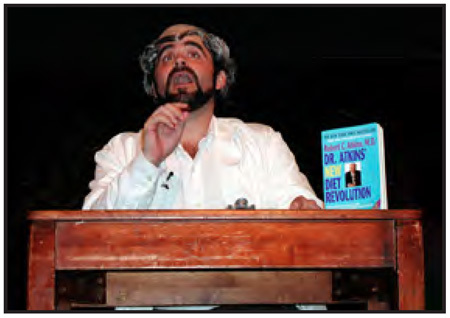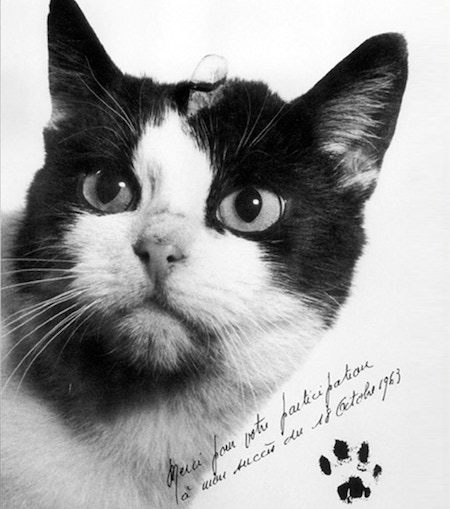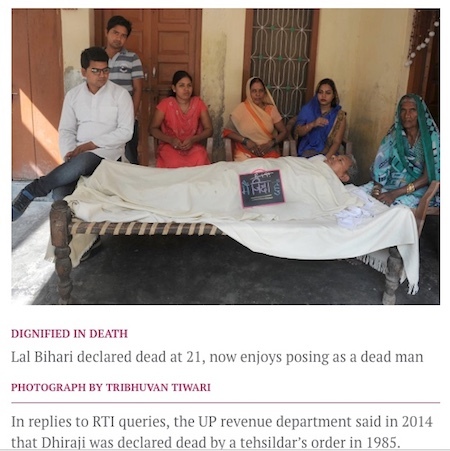Marc Abrahams's Blog, page 177
August 3, 2018
Do small dogs urinate dishonestly? [research study]
The height of dogged dishonesty or honesty, when dogs urinate, gets analyzed in this new study:
“Urine Marking in Male Domestic Dogs: Honest or Dishonest?” B. McGuire [pictured here], B. Olsen, K.E. Bemis, and D. Orantes, Journal of Zoology, epub 2018. The authors, at Cornell University, explain:
Via two studies, we tested the hypothesis that urine marking is a dishonest signal in adult male domestic dogs, which raise a hindlimb when marking vertical objects. In Study 1, we tested whether raised-leg angle (i.e., during a urination, the angle between a dog’s raised leg and the axis normal to the ground) is a proxy for urine mark height (n = 15 dogs) and, in Study 2, we tested whether small dogs exhibit larger raised-leg angles than large dogs (n = 45 dogs).
Our findings support raised-leg angle as a proxy for urine mark height and provide additional evidence that scent marking can be dishonest. Assuming body size is a proxy for competitive ability, small adult male dogs may place urine marks higher, relative to their own body size, than larger adult male dogs to exaggerate their competitive ability. We did not control for over marking, which also may explain our findings.
(Thanks to Adam Marcus and Ivan Oransky for bringing this to our attention, and for pointing out that “fake news” has now become an issue with dogs.)

August 2, 2018
Recent progress in Wonder Woman studies
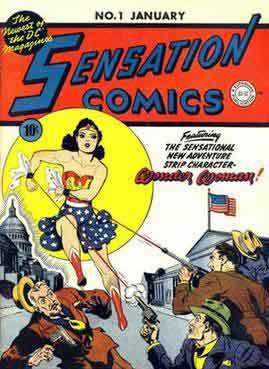 Since her first appearance in 1941, Wonder Woman © has received considerable attention from academia. Here are (but a few) recent(ish) contributions to the literature :
Since her first appearance in 1941, Wonder Woman © has received considerable attention from academia. Here are (but a few) recent(ish) contributions to the literature :
• Wonder Woman, the Gutter, and Critical Genocide Studies
• Loving Lassos: Wonder Woman, Kink, and Care
• An Analysis Of Subtitling Strategies Used In Wonder Woman Movie (2017)
• Wonder Woman: Saving Lives through Just Torture?
• “Tricky” connotations: wonder woman as DC’s brand disruptor
Bonus Factoid ; William Moulton Marston (a.k.a. Charles Moulton) who is widely credited as the originator of Wonder Woman, also contributed to the invention of the Polygraph. More details here.

August 1, 2018
A 400-mile bike ride to an Ig Nobel barbecue
Neil Gussman, who wrangles reporters at the Ig Nobel Prize ceremony, bicycled 400 miles, from Pennsylvania to Massachusetts, to come to an Ig Nobel organizers summer barbecue. Today he blogged about this social side of Ig Nobel organizing:
Riding 400 Miles to a Picnic
…When I arrived, most of the people at the picnic were gathered around the piano in the basement. Each Ig Nobel Prize ceremony since 1996 includes a comic opera that starts and stops and starts again between the awarding of the prizes. This year will be the premiere of “The Broken Heart Opera.” Leading the practice for this year’s opera was Maria Ferrante, the director, and an accomplished soprano who has performed in Grand Operas….
At the piano were two young players, Ivan Gusev from Kazakstan and Yulia Yun from Uzbekistan. They sat together, one playing, then the other, and sometimes they played four handed. They were fun to watch, both as brilliant musicians and the way they interacted as they played. At one point they played “Sheikh of Araby”. Ivan and Yulia played their parts sometimes reaching across each other. At one point Ivan reached too far and Yulia pushed him off the left side of the bench. Ivan rolled onto the floor, and quickly got back onto the piano bench….
Next we moved to the patio, where I met John Barrett. He has been the referee of the Ig Nobel Prize Ceremony for more than twenty years. John keeps time, making sure the 24/7 Lectures, 24-second talk followed by a 7-second summary, do not go over time….
The Ig Nobel Prize ceremony is held every year in Sanders Theater on the campus of Harvard University. This year’s ceremony will be held at 6 p.m. September 13, and webcast live. Since the first ceremony in 1991, the event always occurs before the awarding of the Nobel Prizes. The ceremony gets press coverage in countries around the world, especially those that are home to Ig Nobel (and Nobel) Prize winners….
Every year one or more US-based TV crews from Japanese TV stations show up. Crews from France and Russia are also annual attendees. One of my volunteer jobs for the past seven years has been to keep the Russian crew from Первый Канал(Channel One) within the limits for press people….

Booing/Music/Noise [research study]
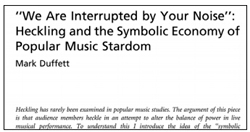 “ ‘We Are Interrupted by Your Noise’: Heckling and the Symbolic Economy of Popular Music Stardom,” Mark Duffett, Popular Music and Society, vol. 32, no. 1, February 2009, pp. 37-57. The author explains:
“ ‘We Are Interrupted by Your Noise’: Heckling and the Symbolic Economy of Popular Music Stardom,” Mark Duffett, Popular Music and Society, vol. 32, no. 1, February 2009, pp. 37-57. The author explains:
“Heckling has rarely been examined in popular music studies. The argument of this piece is that audience members heckle in an attempt to alter the balance of power in live musical performance. To understand this I introduce the idea of the “symbolic economy,” a framework of assumptions and interpretations held by audience members that gives stars their social value. My argument is that each musician’s aura is perceived when his or her performance is both recognizably popular and emotionally meaningful to each fan. Heckling can potentially damage the aura by shifting attention away from the star, condemning the content of his or her performance, and forcing him or her to make an impromptu response. Drawing on theory from sociology and literary studies, the article supplies examples to help us understand the potentials of this process by creating a typology of different heckles.”
 Read that and more, in the column “Music and Noise Research—Explorations of artistic and other vibrations” [free, downloadable PDF], in the special NOISE issue of the Annals of Improbable Research.
Read that and more, in the column “Music and Noise Research—Explorations of artistic and other vibrations” [free, downloadable PDF], in the special NOISE issue of the Annals of Improbable Research.
For heaps of improbable research, subscribe to the magazine (or if you like, buy single issues). The magazine has six new issues a year, all in PDF form.

July 31, 2018
The All-Meat Diet, Then and Now
The All-Meat Diet was fictional when it was the centerpiece of “The Atkins Diet Opera” in 2004. Now someone is promoting the All-Meat Diet as a real diet for real people to follow.

Mikhaila Peterson. Sketch by Nan Swift.
That someone is Mikhaila Peterson. Stephanie Lee reports, in Buzzfeed:
Mikhaila Peterson, 26, is now making money off a new kind of diet that allegedly cured her depression and arthritis: all meat, all the time….
It’s the “carnivore diet,” the latest food trend to sweep the internet, and the 26-year-old swears that it cured her depression and rheumatoid arthritis. Yes, she admits, it “sounds absolutely insane,” there is no research to back it up, and she isn’t qualified to give medical diagnoses. But now she’s offering Skype “consultations” about the diet for about $90 an hour, following in her famous dad’s financial footsteps.
Her father is Jordan Peterson, the University of Toronto psychologist…
“The Atkins Diet Opera” premiered as part of the 2004 Ig Nobel Prize ceremony. This is the fanciful plot:
Dr. Atkins, observing cats munch on birds, invents the perfect diet regimen: eat only meat. Then, after becoming famous and rich, Dr. Atkins finds a way to top himself: he invents the Coffee Diet.
In Act 3, Dr. Atkins [played by Jason McStoots] sings about his All-Meat Diet. Here’s the second verse of that song (which is sung to the tune “An English Country Garden”):
First, understand that protein is GRAND,
in a perfect diet regimen.
Nice juicy MEAT is what you SHOULD eat,
in a perfect diet regimen.
Eat like an aristocrat—Lots of steak, and lots of fat.
Bloody good eating! And what is wrong with that?
Eat it cooked, eat it raw. Oh, just go ahead and gnaw!
It’s a perfect diet regimen.
You can see video of Jason McStoots singing the All-Meat Diet song, and you can read the entire libretto. Here’s an action photo, taken from the audience at the performance:
But enough about the opera. Back to reality: Mikhaila Peterson writes, on her web site, “Now I only eat beef, salt, and drink water.”
We of course wish good health and financial prosperity for Mikhaila Peterson, and for her all-meat-eating father, and for anyone else who ingests their advice!
BONUS: “Portrait of a Self-Recognized Genius: Jordan B. Peterson“

The campaign to honor the first cat in outer space
A cat named Félicette gets ever-widening recognition as being the first cat intentionally (and probably otherwise, too) launched into outer space.
Félicette has many admirers, and has admired research into the history of the thing, and inspired artists, too.
(Thanks to Brent Freeze for bringing this to our attention.)
NOTE: The saga of Félicette should not be confused with the also delightful—but fictional—story of Esther the Cold War Kitty.

A Grizzly-Bear-Suitably Heroic Obituary of a Modern Don Quixote
Troy Hurtubise meets his destiny in a grand obituary, written by Tom Hawthorn, in the (Toronto) Globe and Mail. Here are some highlights:
Troy Hurtubise combined the fevered imagination of a mad scientist with the foolhardy bravery of Evel Knievel in his quest to design a suit impervious to bear attack….
The fanatical mission was chronicled over the years in amateur videos showing a besuited Mr. Hurtubise enduring all manner of violence. He was whacked on the arms with sticks; plonked by a plank to his helmeted head; pummelled by a trio of baseball bat-swinging bikers in the parking lot of a bar. A sledgehammer was swung against his chest. He was poleaxed by a 300-pound swinging log. He was pushed over the Niagara Escarpment, tumbling helmet over boot before crash-landing onto shrubbery at the base. His father deliberately drove a pickup truck into him at 50 kilometres an hour, an act repeated 18 times, each resulting in his being catapulted into the air. He survived that test, as he survived walking through flames….
In 1998, his efforts were rewarded with an Ig Nobel Prize, a parody honouring unusual or trivial scientific achievements. He was feted at a playful ceremony at Harvard University and invited to lecture at the Massachusetts Institute of Technology. Among those who sang his praises was Harvard chemist Dudley Herschbach, himself a Nobel laureate.
A charismatic figure who spoke in a rapid-fire patter, Mr. Hurtubise fit in with elite scientists at Harvard as easily as he did among friends at Country Style donuts in North Bay. He was a flesh-and-blood, 5-foot-8 dreamer inside an indestructible, 7-foot-2 suit, a Canadian original who never did get to test his lifetime’s work against a bruin’s brute force.
We have written a bit—well more than a bit— here about Troy, over the years, most recently with our own tribute: “Exit, pursuing a bear: Farewell Troy Hurtubise.”

July 30, 2018
The farmer, his neuropathic pain and the cow fence
Documented improbable electrical treatments for pain relief are not restricted to shocks from the Nile Catfish. ‘An interesting Case’ is described by Professor Jock Murray of the Division of Neurology, Dalhousie University, Nova Scotia, Canada, in which he relates the bespoke treatment that a Canadian farmer had developed for alleviating constant pain in his leg. It involved a novel use for a Canadian Cooperative Electrical Cow Fence Machine.
“When he awoke with pain each morning he would dress and walk to the pasture, take off the boot on his painful right foot, and place it on the damp earth. Then he would grab the fence wire with his right hand to experience a repetitive jolt of electricity. He would hold on until the pain in his leg waned and then disappeared over 8–10 minutes.”
In the winter months, he brought the machine indoors and rigged it up to a metal saw blade which he stood on to receive the shocks [see photo].
Professor Murray describes a visit to the farmer’s house to witness the treatment :
“He led me to the basement where the electrical machine was sitting on a shelf. Shaking off his boot he placed his foot on the saw blade, grabbed the metal pipe with his hand, and flicked the switch with his free hand. His body stiffened briefly to the pulsating jolts from the clicking machine. He stopped the machine after a few minutes and turned to me. ‘‘Want to try it now, Doc?’’ “
The treatment evidently worked well, because the farmer continued its use for many years, and did not feel the need for any further (conventional) medical assistance.
See: ‘The farmer, his neuropathic pain and the cow fence’ Practical Neurology, Volume 8, Issue 3.

July 27, 2018
Update on Association of Dead People’s Award-winning Founder
Lal Bihari, who founded the Association of Dead People, is back in the news (and he’s still, again, alive). Outlook India magazine reports, with the headline “In UP’s Azamgarh, ‘Living Dead’ Have A Long Legal Battle To Fight“:
… At age 21, Lal Bihari applied for a loan to start a business. The bank wanted proof of identity and other documentation and he went back to his father’s village to get it. That’s when he heard the news of his own death! Now, Lal Bihari didn’t want any property. He just wanted to get on with life. “People called me ghost and satan to my face. They laughed at me. Nobody took it seriously,” says Lal Bihari, who now smiles at every dead joke you can throw at him.
Lal Bihari pleaded with every official possible to rectify the error, but in vain. He also tried many ruses to get an official document to acknowledge him as alive: it became his life’s mission to not be dead….
“I had read of him in a newspaper and kept the clipping for a few years before coming back to it. Since then, Lal Bihari has been like family. His son stayed with me for long periods,” says [Bollywood director Satish] Kaushik. “In 2003, when he won the Ig Nobel awards, the US denied him a visa to go and accept it.” Lal Bihari confirms this. “The US government didn’t want me there. They may have a lot of similar cases there and didn’t want any of them to start staking claims.”
A judgment on Lal Bihari’s case is now taught in some law schools, a scholar is writing a PhD thesis on him…
The 2003 Ig Nobel Peace Prize was awarded to Lal Bihari, of Uttar Pradesh, India, for a triple accomplishment: First, for leading an active life even though he has been declared legally dead; Second, for waging a lively posthumous campaign against bureaucratic inertia and greedy relatives; and Third, for creating the Association of Dead People.
Lal Bihari overcame the handicap of being dead, and managed to obtain a passport from the Indian government so that he could travel to Harvard to accept his Prize. However, the U.S. government refused to allow him into the country. His friend Madhu Kapoor therefore came to the Ig Nobel Ceremony at Harvard University, and accepted the Prize on behalf of Lal Bihari. Several weeks later, the Prize was presented to Lal Bihari himself in a special ceremony in India.
Here’s a TV news report, from several years ago, about Lal Bihari:
Here’s a report about the slightly-fictionalized movie that Satish Kaushik made about Lal Bihari:

Results of the Removement of the Three Minutes Irritating Music [research study]
“Removement of the Three Minutes Irritating Music Produced No Incremental Relaxation,” Wei-Ta Hsiao, Chung-Hung Hong, Hui-Min Wang, Sheng-Chieh Huang, Kai-Yu Shao, Shi-Han Luo, Wei-Chun Chiu, et al., Second International Conference on Innovations in Bio-inspired Computing and Applications (IBICA), 2011, pp. 57-60. IEEE, 2011. The authors, at National Chiao Tung University, Taiwan, report:
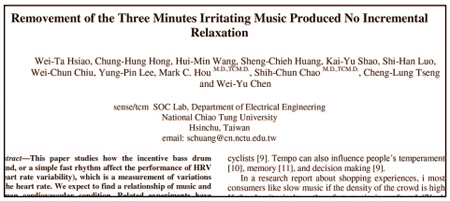
“This paper studies how the incentive bass drum sound, or a simple fast rhythm affect the performance of HRV (Heart rate variability), which is a measurement of variations in the heart rate…. The music have some irritate to human cardiac, just like rock music. From the results of this experiment, we can expect to find the influence of this music type to human cardiovascular condition.”
 Read that and more, in the column “Music and Noise Research—Explorations of artistic and other vibrations” [free, downloadable PDF], in the special NOISE issue of the Annals of Improbable Research.
Read that and more, in the column “Music and Noise Research—Explorations of artistic and other vibrations” [free, downloadable PDF], in the special NOISE issue of the Annals of Improbable Research.
For heaps of improbable research, subscribe to the magazine (or if you like, buy single issues). The magazine has six new issues a year, all in PDF form.

Marc Abrahams's Blog
- Marc Abrahams's profile
- 14 followers


